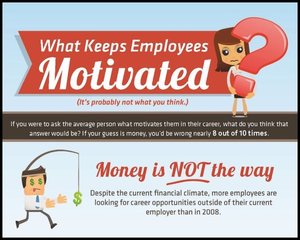 Would you like to learn how to keep employees motivated and keep employee morale high without spending a lot of money?
Would you like to learn how to keep employees motivated and keep employee morale high without spending a lot of money?
What do you think motivates the average person in their career? 80% of people say the answer is not money. This article Is a review of the infographic about employee motivation. A small section of that infographic is pictured on the left.
This information is surprising to most people. After all, we need money to pay our bills, right? However, once basic needs are met, most people are looking for something else. Do you wonder what they’re looking for?
Money Is NOT the Answer
More workers are searching for job opportunities outside of their current company than in 2008, even with current economic conditions.
This can have a negative effect on your company, with higher turnover leading to increased hiring and training costs, as well as lower team synergy.
The Yerkes-Dodson Law
There is an optimal level of arousal for executing tasks. Departure from this level in either direction leads to a decrease in performance.
Translation
Too little pay = Employees too sad about being poor to concentrate on work
Too much pay = Employees too excited about being rich to concentrate on work
This means that there is an optimal amount of pay for an employee to have job satisfaction and be highly productive. Too little pay can lead to low job satisfaction and poor results, while too much pay actually may not help with productivity and results.
The results of this study are amazing. Higher pay for positions requiring cognitive skills leads to lower performance, according to a study by the Federal Reserve Bank of Boston.
Using their talents, career development, and training are the leaders of job satisfaction for employees everywhere.
This means that you have a variety of options and opportunities to motivate employees and achieve job satisfaction, other than using the more costly way of simply offering more money.
Main Motivators: Valued More Than Money.
The Need for Recognition
- 78% of workers named recognition as their main motivator in their jobs
- 69% of workers state if they were given more recognition, they would give more effort
- 52% of workers are not happy with their current amount of recognition
- 49% of workers state they would leave their current position for a company that better recognized their efforts
- 39% of workers do not feel they get enough appreciation in the workplace
These findings suggest that employees definitely want more from their job than a higher paycheck. They want to have their efforts recognized in order to be motivated in their work. Many employees, according to this research, feel neglected and not fully appreciated at their workplace.
Engagement Is the Answer
Engagement motivates employees, more than money, at work, according to the same Federal Reserve study.
Engaged Employees Statistics
- 78% of employees would recommend the products and services of their company
- 70% believe they know how to meet the needs of their customers
- 58% state their position stimulates their creativity
Employee engagement is the way to keep employees motivated and producing high quality results at work. Engagement makes employees feel more committed to the company, and leads to them figuring out better ways for the company to succeed.
Pitfalls of Disengagement
- Disengaged workers are defined as basically sleepwalking through their work
- 18% of employees hurt the success of their co-workers when they are disengaged
- 72% of employees consider themselves currently disengaged
- $370 billion of yearly productivity in the U.S. is lost because of employees being actively disengaged
- 69% of HR workers see employee engagement as a major challenge facing companies in the future
It is actually damaging to have disengaged employees at your workplace, as disengagement leads to negativity, boredom, and a lack of productivity. This results in the loss of billions of dollars annually in the U.S.
Employee Motivation Solutions
Coaching
Having employee talent, interests, and needs meet the objectives of the company. Working one-on-one with employees on a regular basis will help them become more successful. It will make employees feel more valuable because you are spending time helping them. This engagement between managers and employees is essential to employee motivation.
Relationships
Develop personal, trusting bonds between management and workers, and between co-workers. The bond between managers and employees develops trust through open communication. The bond between employees and their co-workers develops when they get to know each other on a more personal level.
You can provide employee morale boosters. These are activities that help employees
- get to know each other,
- have fun together, and
- appreciate each other.
Employees who have fun together, work better together, are more motivated, and have higher levels of employee morale.
Dialogue
Support open and frequent talks with employees to prevent problems that lead to disengagement. If you find that employees are reluctant to talk, ask them fill out anonymous employee morale surveys that will help you understand which of the 7 key aspects of employee morale need improvement.
In a nutshell, the infographic explains how increasing job satisfaction, raising employee morale, and keeping employees motivated requires a multi-faceted approach. The solutions listed above will lead to success without a large financial investment. This will result in happier, productive, and loyal employees and greater success for their companies.
What do you think? We would love your opinion.
What has been your experience either as a supervisor, manager, or employee. Please leave your comments below.